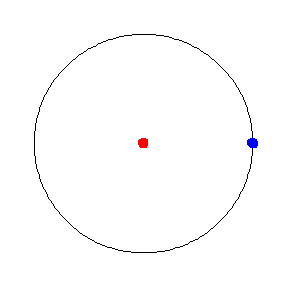A particle
is said to be undergoing uniform circular motion if its radius
vector in appropriate coordinates has the form
, where
|
(1)
| |||
|
(2)
|

Geometrically, uniform circular motions means that moves in a circle in the
-plane with some radius
at constant speed. The quantity
is called the angular
velocity of
.
The speed of
is
|
(3)
|
and the acceleration of P has constant magnitude
|
(4)
|
and is directed toward the center of the circle traced by . This is called centripetal acceleration.
Ignoring the ellipticity of their orbits, planet show nearly uniform circular motion about the Sun. (Although due to orbital inclinations, the orbital planes of the different planets are not necessarily coplanar.)